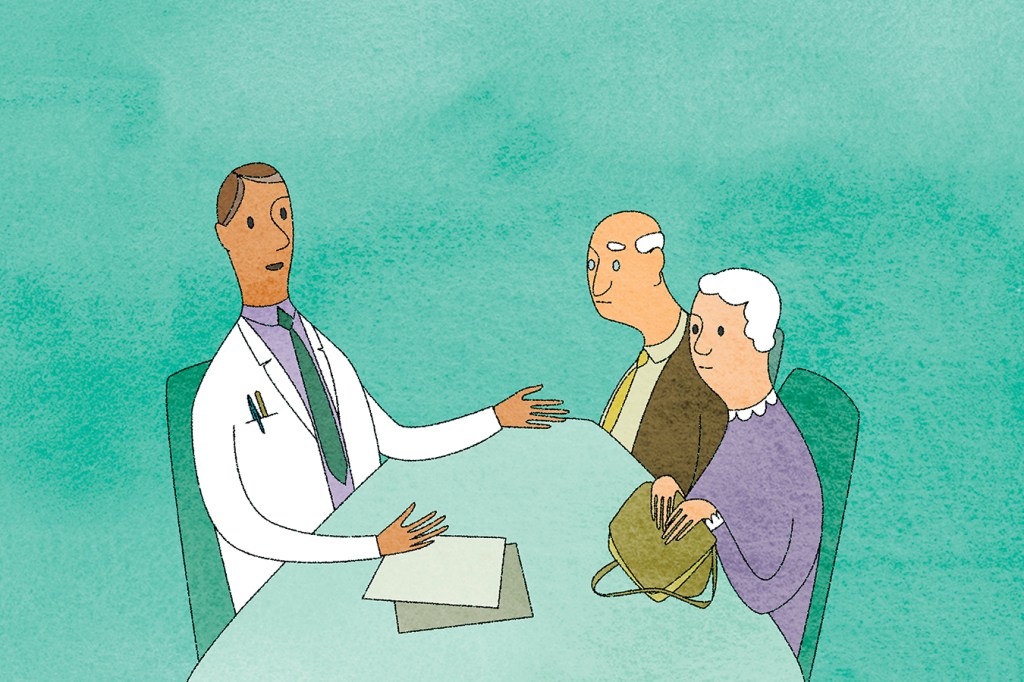Being old and sick in America frequently means a doctor won’t ask you about troublesome concerns you deal with day to day — difficulty walking, dizziness, a leaky bladder, sleep disturbances, memory lapses and more.
It means that if you’re hospitalized, you have a good chance of being treated by a physician you’ve never met and undergoing questionable tests and treatments that might end up compromising your health.
It means that if you subsequently seek rehabilitation at a skilled nursing facility, you’ll encounter another medical team that doesn’t know you or understand your at-home circumstances. Typically, a doctor won’t see you very often.
In her new book, “Old & Sick in America: The Journey Through the Health Care System,” Dr. Muriel Gillick, a professor of population medicine at Harvard Medical School and director of the Program in Aging at Harvard Pilgrim Health Care Institute, delves deeply into these concerns and why they’re widespread.
Her answer: a complex set of forces is responsible. Some examples:
- Medical training doesn’t make geriatric expertise a priority.
- Care at bottom-line-oriented hospitals is driven by the availability of sophisticated technology.
- Drug companies and medical device manufacturers want to see their products adopted widely and offer incentives to ensure this happens.
- Medicare, the government’s influential health program for seniors, pays more for procedures than for the intensive counseling that older adults and caregivers need.
In an interview, Gillick offered thoughts about how older adults and their caregivers can navigate this treacherous terrain. Her remarks have been edited for clarity and length:
Q: What perils do older adults encounter as they travel through the health care system?
The journey usually begins in the doctor’s office, so let’s start there. In general, physicians tend to focus on different organ systems. The heart. The lungs. The kidneys. They don’t focus so much on conditions that cross various organ systems, so-called geriatric syndromes. Things like falling, becoming confused or dealing with incontinence.
Q: What can people do about that?
Older people are often unwilling to bring these issues to the attention of their doctors. But if a family member is accompanying the patient, they should speak up.
In some practices, a nurse practitioner may be more attuned to these issues than the physician. So, it’s a good idea to learn who in the medical office you go to is good at what.
Another approach is to request a geriatric assessment or consultation that will bring these issues to the forefront.
Q: How do geriatric assessments work?
A geriatric assessment does two major things. It looks at the whole person. And it focuses on that person’s functioning — on what they can do. Can they dress themselves, walk, get to the bathroom? Can they cook meals? Take a bus downtown? Balance their checkbook?
An outpatient geriatric assessment is typically 1½ to two hours and conducted by an interdisciplinary team. A social worker or a mental health professional will ask about the person’s family situation. Are they living alone? Do they have support? A nurse practitioner will look at physical function. And a physician will go over medical concerns and examine the cognitive performance of the individual. Then, the team pulls all these pieces together to look at what’s going on with that person.
When someone starts being frail — having consistent difficulty doing things — an assessment of this kind is often a good idea.
Q: The next step you talk about in your book is the hospital.
One of the big perils in the hospital is technology, which is also its great virtue. Technology can improve quality of life and be life-extending. But, sometimes, it creates endless complications.
An example are imaging tests such as CT scans. Physicians hardly think of this as an invasive test. But often one has to administer a dye to see what’s going on. That dye can cause kidney failure in someone with impaired kidney function — something that’s common in older adults.
Sometimes there’s no real need for scans. An example would be an older person who becomes acutely confused in the hospital, which happens a lot. The appropriate response is to look at what’s causing the confusion and take away the offending agent. Often, that’s a medication that was started in the hospital. Or, it’s an infection. But the routine knee-jerk reaction is to do a CT scan to rule out the possibility of a stroke or bleeding in the brain.
For the most part, doctors want to do whatever it takes to diagnose a problem. For younger patients, this may make sense. But for frail older patients with multiple medical conditions, a cascade of complications can result.
Q: What do you advise older patients and their families do?
When a test is proposed, ask the doctor “how important is it to pursue this diagnosis” and “how will the results change what you do?”
It’s also reasonable to say something along the lines of “every time I’ve had a test, it seems like I get into some kind of trouble. So, I really want to know, with this test or this treatment, what kind of trouble could I get into?”
Q: In your book, you talk about how a doctor-patient relationship can be sidelined when someone goes to the hospital. Instead, hospitalists provide care. How should people respond?
It’s really important to give that doctor a sense of the patient and who they are. Say, your 88-year-old mother is in the hospital, and she’s become profoundly confused. The doctor doesn’t know what she was like a week or a month ago. He may assume she has dementia unless he hears otherwise. He won’t understand it might be delirium.
You or a caregiver want to come across as someone who can make it easier for the doctor to do his or her job — versus someone who’s a nuisance. You want to build trust, not annoyance.
Q: What about skilled nursing facilities?
These are settings that people go to after the hospital, to get rehabilitation. Typically, the contact with doctors is minimal after an initial evaluation, though there’s a spectrum as to how much medical care there is.
A subset of older adults go to rehab just to get physical therapy after they’ve had a joint replacement or a hip fracture. They are really pretty stable, medically. If they get good physical therapy and nursing care, it’s probably OK that the doctor isn’t around much.
But there are also older patients who come to skilled nursing facilities, or SNFs, after having had one complication after another in the hospital. These patients can be very fragile, with many medical problems. They’re at risk of getting some new problem in the SNF — perhaps an infection — or an exacerbation of one of the problems they already have that hasn’t resolved.
Q: What do you recommend?
When you arrive at an SNF, it’s a new cast of characters. A physician whom you’ll see fleetingly. Nurses. Physical therapists. Aides. If you’re a caregiver, make sure you have face-to-face time with these staffers.
SNFs are required within the first week or so to have a care planning meeting with the team. They’re supposed to invite patients and their representatives to the meeting. This is a good place to say something along the lines of “My mother has been through a lot, and now that we’ve met you and seen what you can do, we’d like you to do your best to treat her here and not send her back to the hospital.”
You have to have trust to make that happen. The family has to trust the medical team. And the team has to trust that the family isn’t going to get upset and sue them. A meeting of this kind has the potential to allow everyone to figure out what’s important and what the plan will be going forward.
We’re eager to hear from readers about questions you’d like answered, problems you’ve been having with your care and advice you need in dealing with the health care system. Visit kffhealthnews.org/columnists to submit your requests or tips.
KFF Health News' coverage of these topics is supported by John A. Hartford Foundation and The SCAN Foundation







